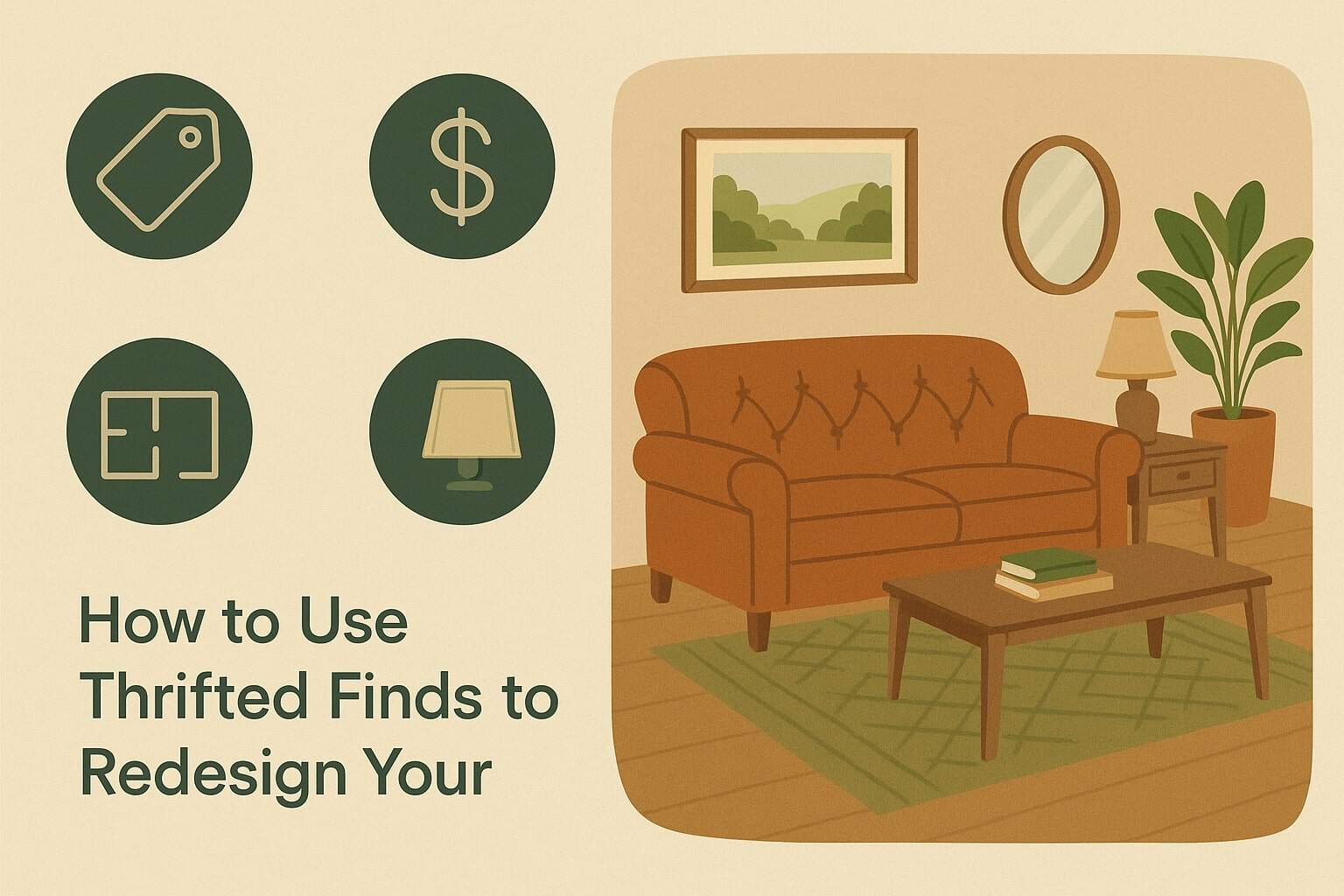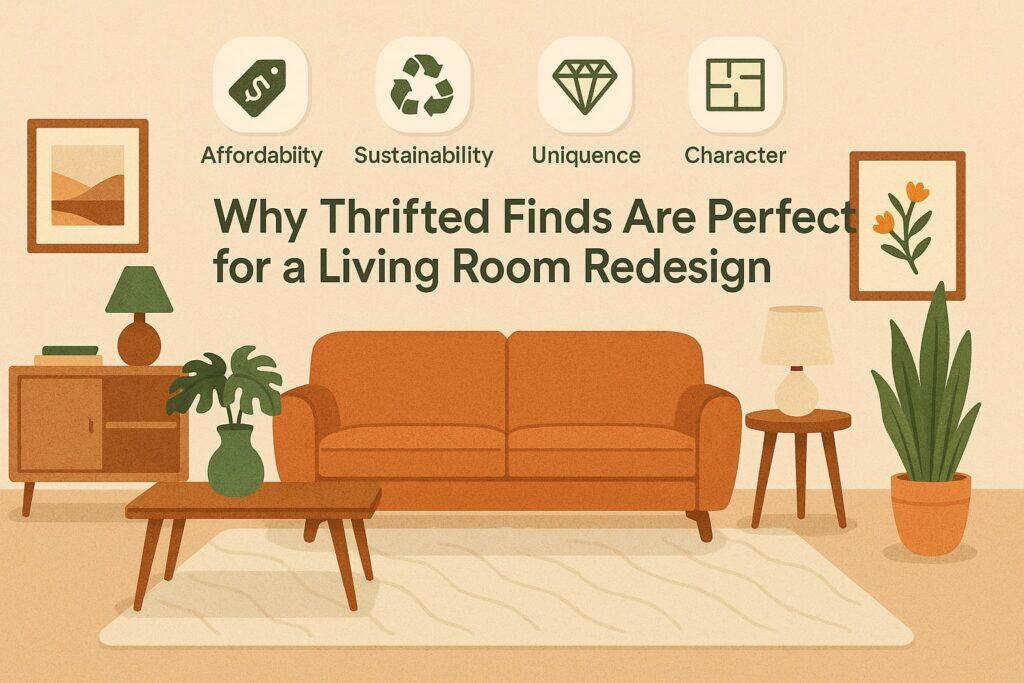
By bric-a-brac-montroyal November 5, 2025
Redesigning a living room with thrifted finds is part treasure hunt, part design school, and part sustainability win. The right secondhand pieces can deliver character, quality, and value that mass-produced items can’t match—without sacrificing comfort or function.
With a smart plan, you can turn thrifted finds into a cohesive room that feels curated rather than cluttered, and stylish rather than “student chic.” This guide breaks the process into clear, repeatable steps so you can shop with confidence, restore pieces like a pro, and style a space that reflects your taste and your budget.
Thrifted finds also punch above their weight environmentally. Buying pre-loved furniture saves items from landfills and reduces demand for new manufacturing, which often consumes energy and materials.
On the financial side, many older pieces were constructed with better joinery and hardwoods, offering longer life at lower prices. Finally, the thrill of discovering a unique lamp, a sculptural chair, or a solid wood sideboard adds joy to the journey.
Use the techniques in this article to set a vision, source strategically, evaluate quality, and elevate every item you bring home—then tie your thrifted finds together with layout, color, and styling that feels intentional and fresh.
Why Thrifted Finds Are Perfect for a Living Room Redesign

A living room works hard—hosting conversations, streaming nights, work-from-sofa sessions, and quiet reading. Thrifted finds excel here because they often deliver durability and soul. Many vintage frames use kiln-dried wood, mortise-and-tenon joints, and coil or eight-way hand-tied springs, giving you structure that stands up to daily use.
Even when a piece shows wear, surface refreshes are affordable fixes compared with buying new. When you build a scheme around thrifted finds, you can allocate more budget to reupholstery, custom cushions, or professional refinishing, which raises the perceived value of the entire room.
There’s also a variety. Thrifted finds span decades of styles—mid-century lines, Art Deco curves, farmhouse patina, postmodern silhouettes—so you can combine eras for a layered look.
If you prefer minimalism, target streamlined case goods and neutral upholstery; if you lean eclectic, mix textures like leather, bouclé, jute, and brushed brass.
Because most thrifted finds are one-of-a-kind, your living room won’t look like anyone else’s. The key is editing: choose pieces that share visual DNA through color temperature, wood tones, or repeated shapes, so the room feels collected—not chaotic.
A Practical Quality Checklist for Thrifted Finds
Quality inspection is where thrifted finds go from “maybe” to “must-have.” Start with structure: wiggle the arms and back of a chair; it should not twist independently of the seat. Check for wobble, gaps in joints, and evidence of water damage.
With case goods, pull drawers to confirm dovetails, smooth slides, and intact bottoms. Solid woods often show grain on cut edges; veneers are fine if they aren’t bubbling or chipping. For upholstered thrifted finds, lift cushions and press into the deck; sagging suggests tired springs or webbing, which is fixable but adds cost.
Smell matters: smoke or mildew can be reduced, but deep odors may require full reupholstery. On lighting, verify the socket, cord, and plug; factor rewiring into your budget if the lamp is older. For rugs, check edges and knots; small frays can rebound, but moth damage spreads. Photograph issues under good light so you can price repairs.
Assign each potential purchase a “restore score” based on materials, labor, and payoff. This keeps the magic of thrifted finds grounded in realism—and helps you pass on pieces that will drain more time and money than they’re worth.
Define Your Style Vision and Color Story Around Thrifted Finds

Before you shop, decide what you want the room to feel like. Pick three style keywords—e.g., “warm,” “tailored,” “collected”—and let those words filter every choice of thrifted finds.
Next, write a behavior brief: list top activities (hosting, gaming, reading) and the non-negotiables (a sectional, a reading lamp near the armchair, a low-glare media wall). This brief prevents impulse buys that don’t serve your life.
Translate the brief into a color story: one dominant neutral (greige, camel, charcoal), one supporting neutral (blackened bronze, off-white), and one to two accent hues (sage, terracotta, indigo).
Think in finishes as well as colors. If your thrifted finds include multiple woods, keep undertones consistent: all warm (honey oak, teak) or all cool (walnut, ebonized ash). Metals can mix when you repeat each at least twice—say, aged brass on a floor lamp and picture frames, matte black on curtain rods and cabinet hardware.
Fabrics should balance texture: if your sofa is smooth linen, add nubbly knits, a jute rug, or bouclé pillows. With a clear vision, every piece of your thrifted finds will reinforce the same narrative, making even bold choices feel cohesive.
Build a Mood Board That Directs Your Thrifted Finds
Create a simple mood board to guide purchases. Include your paint swatches, fabric samples from potential reupholstery, and screenshots of rooms you admire. Add photos of target thrifted finds—like a tulip side table or a campaign chest—so you recognize them quickly in the wild.
Use a grid: top row for color, middle for furniture silhouettes, bottom for styling cues (art, plants, books). Label each image with a role: “anchor sofa,” “statement chair,” “storage hero,” “lighting layer.” This stops you from buying five side tables just because they were cute.
Next, define “allowable swaps.” If your perfect leather sling chair doesn’t appear, what’s the backup? Maybe a woven cane armchair or a bentwood rocker that gives the same airiness.
Set size targets too: note maximum sofa length, coffee table width, and rug dimensions based on your room. Keep the board on your phone; when you evaluate thrifted finds, ask if the item supports the board or fights it.
Periodically refine the board as you learn more from shops and marketplaces. The mood board becomes a north star so each of your thrifted finds pushes the design forward.
A Smart Sourcing Strategy to Score the Best Thrifted Finds

Great rooms start with great hunting habits. Rotate among sources to diversify what you see: charity shops mid-week, estate sales on Saturdays, flea markets monthly, and online classifieds and marketplaces daily.
Follow local sellers and dealers; many post previews in stories or announce drop-offs ahead of time. Showing up early matters for premium thrifted finds like solid-wood credenzas, marble-top tables, or vintage leather club chairs.
For bulky pieces, bring a tape measure, painter’s tape, and a folded measuring card with your room’s key dimensions so you can verify fit on the spot.
When scouting online, set alerts with keywords that match your mood board—“teak sideboard,” “campaign dresser,” “brass pharmacy lamp,” “wool rug 8×10.” Learn brand tells that signal quality: drawer dovetails, solid backs, weight, and designer marks.
Save a folder of price comps to spot deals. Consider geography too: neighborhoods with older housing stock often yield mid-century or traditional classics; college towns skew toward newer budget items.
Cast a wide net, but keep discipline. Your thrifted finds should fill roles on your plan, not add clutter. A consistent sourcing cadence pays off with steady, strategic wins.
Online and Offline Channels That Elevate Your Thrifted Finds
Each channel has strengths. Thrift stores are best for lamps, art, frames, and occasional tables. Habitat-style reuse stores often carry doors, mantels, and lighting suitable for statement moments.
Estate sales are the jackpot for rugs, solid-wood case goods, and sets of dining chairs you can split—two for the living room, four for the kitchen.
Flea markets and antique malls provide curated thrifted finds with slightly higher pricing but better condition and selection; vendors expect negotiation. Online marketplaces deliver scale and speed, letting you filter by distance, size, and price, and message sellers fast.
Work your network. Tell friends you’re collecting thrifted finds and share your mood board; people love helping rehome pieces. Watch building move-out days and local auction houses for deals on art and vintage lighting.
Consider non-traditional sources: hotel liquidators often sell durable furniture made for heavy use; commercial offices unload quality sofas and side chairs when remodeling.
Pair these channels with a pickup plan—keep moving blankets, ratchet straps, and a dolly ready. The more friction you remove from logistics, the easier it is to say yes to the perfect thrifted finds when they appear.
Transforming Thrifted Finds: Clean, Repair, and Upcycle Like a Pro
The magic of thrifted finds often appears after cleaning and minor repairs. Start gentle: vacuum crevices, then wipe wood with a solution of mild soap and water, drying immediately. Follow with mineral spirits to remove waxy buildup, then feed the wood with a conditioner or oil if appropriate.
For finish damage, try a blend stick or wax crayon on small scratches; reserve sanding for pieces you plan to refinish fully. On metal, use a non-abrasive polish; if patina is desirable, clean without over-brightening. Glass and mirrors respond well to vinegar-based cleaners and fresh backing if the silvering has deteriorated.
Textiles need a plan. For removable covers, wash according to fiber; for fixed upholstery, spot-treat with fabric cleaner and a soft brush, then extract moisture with a wet/dry vacuum to prevent rings.
Consider reupholstery on high-touch pieces—your thrifted finds will look custom and last longer. Replace tired foam with high-resilience or natural latex for comfort.
For rugs, get a professional wash if the piece is valuable; otherwise, beat outside, vacuum both sides, and treat stains before laying a quality rug pad. Thoughtful refreshes reveal the beauty that made you choose those thrifted finds in the first place.
Refinishing, Reupholstery, and Creative Flips for Thrifted Finds
When a surface is beyond quick fixes, refinishing provides a clean slate. Strip old finish with a safer, low-odor stripper, then sand progressively (120→150→220) along the grain. Stain to unify mismatched tones, or go natural and seal with a hardwax oil for a matte look.
Swap dated hardware for timeless knobs or pulls—repeat the metal elsewhere for cohesion. For painted makeovers, clean, sand, prime for adhesion, and use enamel or cabinet-grade paints for durability. Consider two-tone effects: painted bases with sealed wood tops keep your thrifted finds elevated.
Reupholstery transforms silhouettes. A tuxedo-arm sofa in a textured neutral, a barrel chair in mohair, or a channel-back slipper chair in bouclé can become the star of the room. If full reupholstery isn’t in budget, add tailored slipcovers or new cushion cores and high-quality fabric on just the seats.
Creative flips include converting a low dresser into a media console by adding vent holes and wire grommets, or turning a trunk into a coffee table with a glass top. Each thoughtful modification keeps the integrity of your thrifted finds while aligning them with your living room’s updated design.
Layout, Styling, and Cohesion: Pulling Thrifted Finds Together
A great layout makes even modest furniture feel intentional. Start with zones: conversation, media viewing, and reading. Place your largest piece—the sofa—first, ensuring a clear path through the room. Aim for 40–60 cm (16–24 in) of clearance around coffee tables and 90 cm (36 in) for primary walkways.
Let seating face each other with a coffee table that’s two-thirds the sofa length; top height should meet the sofa seat. For a small room, float furniture off the walls; for a large room, define zones with layered rugs and lighting.
Unify your thrifted finds with repetition. Repeat a wood tone at least twice, echo a metal finish, and link shapes—arched lamp, rounded ottoman, curved art—so the eye connects elements. Use three lighting layers: ambient (ceiling), task (reading lamps), and accent (picture lights, sconces).
Anchor the palette with your rug or sofa; then introduce accent color in pillows, throws, and art. Edit ruthlessly—leave breathing space on surfaces. When your thrifted finds share visual cues and your layout supports how you live, the room feels cohesive and calm.
Styling Moves That Make Thrifted Finds Look Designer
Designer styling is about proportion, contrast, and storytelling. Stack books to vary height on a coffee table, then add a tray to corral remotes and a small sculpture sourced from your thrifted finds. On shelves, mix vertical book rows with horizontal stacks and negative space; weave in vessels, framed photos, and a plant for texture.
Pillows look best in odd numbers—three on a sofa, one on each chair—with a mix of solids, patterns, and textures. Layer window treatments: simple linen panels with a discreet blackout roller feel luxe and practical.
Use asymmetry to avoid a catalog look. Balance a heavy sideboard with a large piece of art on one side and a tall plant on the other. Cluster art in a gallery wall using consistent frame colors; your thrifted finds can include vintage frames and original prints. Introduce life with greenery—olive trees, rubber plants, or pothos—plus a low-maintenance bouquet.
Finally, curate scent with candles or diffusers. These styling habits turn thrifted finds into a collected narrative, elevating the entire living room without demanding a designer budget.
Budget, Negotiation, and Logistics for Thrifted Finds
Set a total budget and split it into buckets: anchor seating (40–50%), storage and tables (25–30%), lighting (10–15%), textiles and art (10–15%), and a contingency (10%). Track a parallel “restore budget” covering fabric, foam, finish supplies, hardware, cleaning, and delivery or tool rental.
This second column prevents sticker shock after the purchase. For negotiation, research price comps, then make polite, fair offers—typically 10–25% below ask for common items and list price for rare pieces. Bundle items with sellers to unlock bigger savings on your thrifted finds.
Plan logistics before you shop big. Measure doorways, stair turns, and elevator clearances; map a route for large items. Keep moving blankets, straps, and furniture sliders handy. If delivery is needed, compare quotes and factor them into total cost when deciding between similar thrifted finds.
Timing also saves money: shop mid-week for fresh donations, the last day of estate sales for discounts, and off-season for rugs and outdoor pieces. The more you control budget and logistics, the more confidently you can say yes to truly exceptional thrifted finds.
Hidden Costs, Timing, and Risk Management with Thrifted Finds
Hidden costs add up. Foam and fabric for a sofa can rival the purchase price; premium hardware or professional refinishing may exceed the cost of the piece. Build a risk allowance for unknowns like stripped screws, stuck drawers, or unseen damage.
Consider tools as investments: an orbital sander, a staple remover, clamps, and a quality brush set pay dividends across multiple thrifted finds. Time is another currency—schedule restoration blocks on weekends and sequence projects so the room remains functional while you work.
Create decision rules to reduce regret. For example: buy only if the piece fits your mood board, passes the quality checklist, and you can store it safely until installation. If a piece breaks a rule, you need a strong reason to proceed.
Keep receipts and seller info for follow-ups. When in doubt, sleep on it; truly great thrifted finds are rare but not singular, and the right one will align with your budget, timeline, and design vision without strain.
Maintain and Future-Proof Your Thrifted Finds
Care routines extend the life of your investment. Rotate cushions monthly, flip rugs every six months, and vacuum upholstery with a soft brush weekly. Use coasters and trays to prevent water rings on wood thrifted finds, and apply felt pads under decor.
For wood, dust with a dry cloth and refresh with an appropriate conditioner seasonally; avoid silicone polishes that build residue. Tighten chair screws and bolts twice a year to prevent wobble. On leather, condition lightly to prevent cracking, and keep textiles out of direct sun to slow fading.
Future-proofing is design insurance. Choose performance fabrics for reupholstery, add zippered covers to cushions, and use washable slipcovers in high-traffic homes. Select modular lighting—table lamps plus plug-in sconces—so you can change layouts without rewiring.
Keep a “repair kit” for thrifted finds: touch-up markers, wax fill sticks, wood glue, clamps, and extra cabinet bumpers. Document finish names, fabric SKUs, and rug sources for later touch-ups.
With steady care and smart upgrades, your thrifted finds will age beautifully and remain the backbone of your living room for years.
Seasonal Refreshes That Keep Thrifted Finds Feeling New
A seasonal refresh maintains momentum without major spending. In warmer months, swap heavy throws for lightweight linen, rotate in botanical art, and add woven baskets for airy storage. In cooler seasons, bring back wool throws, textured pillows, and candlelight.
Re-style shelves with different color accents drawn from your thrifted finds—brass in autumn, glass and ceramics in spring. Move a chair to create a new reading nook or swap lamps between corners; these micro changes re-energize the room.
Schedule deep cleans seasonally: wash slipcovers, steam curtains, condition wood, and send rugs for professional cleaning as needed. Reassess the layout after gatherings or life changes—if a new hobby or pet shifts how you use the room, adapt zones accordingly.
Because thrifted finds are unique and flexible, they accommodate these transitions gracefully. The result is a living room that feels current year-round while keeping your design identity intact.
FAQs
Q.1: How do I make a room look expensive using mostly thrifted finds?
Answer: Start with scale and quality. Anchor the room with one or two “hero” pieces—perhaps a substantial solid-wood credenza or a sculptural lounge chair—that broadcast craftsmanship. Keep the palette tight and the styling restrained so the eye reads calm, not clutter.
Upgrade touchpoints: new down-alternative pillow inserts, crisp lamp shades, and lined curtains elevate inexpensive frames and thrifted finds. Use real materials—linen, wool, wood, stone—whenever possible.
Finally, prioritize lighting. A layered lighting plan with dimmers and a statement floor lamp instantly raises the perceived value of your thrifted finds and the entire room.
Q.2: Is reupholstery worth it for thrifted finds, or should I buy new?
Answer: It depends on the frame. If a sofa or chair has a sturdy hardwood frame, good lines, and springs that can be retied, reupholstery is often a better long-term value than buying a budget new piece.
You get custom fabric, fresh foam, and the exact fit for your room—plus the satisfaction of reviving thrifted finds. Price out fabric (meterage plus a 10% overage), labor, new foam, and pickup/delivery.
If the total approaches the cost of a high-quality new item with similar specs, reupholstery still wins because the frame quality is usually superior and the result is unique.
Q.3: How do I keep my thrifted finds cohesive if they’re all different styles?
Answer: Use a unifying palette and repeated materials. Choose one dominant wood tone and one metal finish, then repeat them across the room. Keep upholstery in two or three related neutrals to calm varied silhouettes.
Tie styles together with shape echoes—rounded corners, tapered legs, or boxy forms—and with consistent rug and curtain choices. Limit patterns to one hero pattern and two supporting textures.
With these rules, even diverse thrifted finds read as a deliberately collected whole rather than a random assortment.
Conclusion
Redesigning with thrifted finds is a craft you can learn and repeat. Define the feeling you want, translate it into a color and materials story, and shop with a focused mood board. Evaluate quality with a clear checklist, then restore, refinish, and reupholster where it pays off.
Plan a people-first layout, layer lighting and texture, and edit styling so every piece earns its place. Manage budget and logistics like a project manager, and maintain your investments with simple routines and seasonal refreshes.
Do this, and your thrifted finds will become the backbone of a living room that looks elevated, functions beautifully, and tells your story—without breaking the bank or the planet.